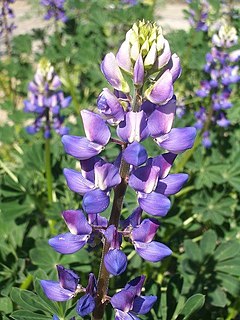
Lupinus succulentus is a species of lupine known by the common names hollowleaf annual lupine, arroyo lupine, and succulent lupine.

Lupinus bicolor is a species of lupine known as the miniature lupine, Lindley's annual lupine, pigmy-leaved lupine, or bicolor lupine.
Lupinus andersonii is a species of lupine known by the common name Anderson's lupine.
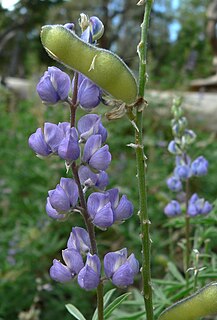
Lupinus argenteus is a species of lupine known by the common name silvery lupine. It is native to much of western North America from the southwestern Canadian provinces to the southwestern and midwestern United States, where it grows in several types of habitat, including sagebrush, grassland, and forests. This is a perennial herb growing erect to heights anywhere between 10 centimetres (3.9 in) and 1.5 metres (4.9 ft). It is sometimes silvery-hairy in texture and sometimes nearly hairless. Each palmate leaf is made up of 5 to 9 leaflets each up to 6 centimetres long. They are narrow and linear in shape, under a centimetre wide. The inflorescence bears many flowers, sometimes arranged in whorls. The flower is 5 millimetres (0.20 in) to 14 millimetres (0.55 in) long and purple, blue, or whitish in color. The banner, or upper petal, of the flower may have a patch of white or yellow. The fruit is a hairy legume pod up to 3 centimeters long containing several beanlike seeds. The plant is an important food source for butterflies. It also attracts birds and hummingbirds.
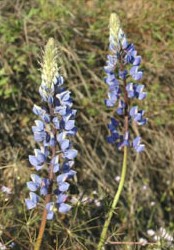
Lupinus benthamii is a species of lupine known by the common name spider lupine.

Lupinus brevicaulis is a species of lupine known by the common names shortstem lupine and sand lupine. It is native to the southwestern United States and Great Basin area and into northern Mexico, where it grows in many types of sandy habitat. This is a hairy annual herb growing nearly flat in a spread on the ground with a stem just a few centimeters long. An array of leaves encircles the base. Each palmate leaf is made up of 6 to 8 leaflets about a centimeter long and a few millimeters in width. The inflorescence is a petite spiral of flowers a few centimeters long just arising past the basal disc of leaves. Each flower is 6 to 8 millimeters long and bright blue in color, generally with a white or yellowish spot on its banner. The fruit is a hairy legume pod about a centimeter long containing 1 or 2 beanlike seeds.
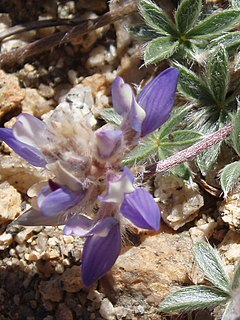
Lupinus breweri is a species of lupine known by the common names Brewer's lupine and matted lupine. It is native to much of California, except for the deserts, and to adjacent sections of Oregon and Nevada, where it is common in some areas, particularly mountain forests. Quite short for a lupine, this is a hairy, mat-forming perennial herb, sometimes becoming like a shrub, with a woody base. The leaves spread out from the stem. Each palmate leaf is made up of 5 to 10 woolly leaflets each up to 2 centimeters (0.79 in) long. The inflorescence is a dense raceme of flowers a few centimeters tall, each flower 4 to 11 millimeters. The flower is blue or purple with a white or yellowish spot on the banner. The fruit is a silky-hairy legume pod 1 or 2 millimeters long.
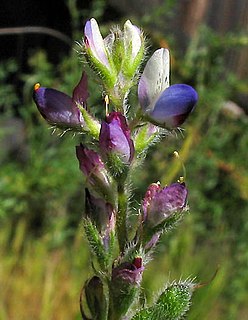
Lupinus concinnus is a species of lupine known by the common name Bajada lupine. It is native to the southwestern United States from California to Texas, and northern Mexico, where it is known from many types of habitat. This is a hairy erect or decumbent annual herb with a stem growing 10 to 30 centimeters long. Each small palmate leaf is made up of 5 to 9 leaflets up to 3 centimeters long and under a centimeter wide, sometimes narrow and linear in shape. The inflorescence is a dense spiral of flowers, with some flowers also appearing in leaf axils lower on the plant. Each flower is 5 to 12 millimeters long and purple, pink, or nearly white in color. The fruit is a hairy legume pod around a centimeter long.

Lupinus flavoculatus is a species of lupine known by the common name yelloweyes, or yellow-eyed lupine.,
Lupinus grayi is a species of lupine known by the common name Sierra lupine. It is endemic to California, where its distribution extends the length of the Sierra Nevada and its foothills and includes the Tehachapi Mountains.
Lupinus hyacinthinus is a species of lupine known by the common name San Jacinto lupine. It is native to the mountains of southern California and adjacent Baja California, where it grows in dry areas, often in pine forests. It is a perennial herb growing erect to a maximum height of one meter. It is hairy in texture, its newer herbage gray-green in color. Each palmate leaf is divided into up to 12 narrow leaflets up to 8 centimeters long and a few millimeters wide. The inflorescence bears whorls of flowers each over one centimeter long. The flower is purple or blue with a white to yellow patch on its banner. The fruit is a silky-haired legume pod 3 or 4 centimeters long containing speckled seeds.
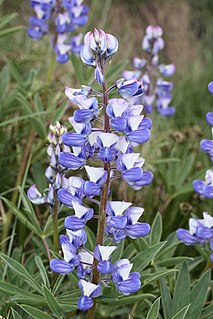
Lupinus latifolius is a species of lupine known by the common name broadleaf lupine. It is native to western North America from British Columbia to Baja California to New Mexico, where it is common and can be found in several types of habitat. There are several subtaxa, described as subspecies or varieties, some common and some rare. They vary in morphology. In general this plant is an erect perennial herb. It grows 30 centimeters to over two meters in height, in texture hairy to nearly hairless. Each palmate leaf is made up of several leaflets, those on larger plants up to 10 centimeters long. The inflorescence bears many flowers, sometimes in whorls. Each flower is one to two centimeters in length, purple to blue to white in color, the spot on its banner yellowish, pinkish, or white.
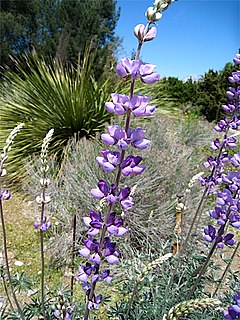
Lupinus longifolius is a species of lupine known by the common name longleaf bush lupine.
Lupinus nevadensis is a species of lupine known by the common name Nevada lupine. It is native to the western Great Basin in Nevada and adjacent sections of Oregon and California, where it grows in sagebrush and other typical basin habitat. It is an erect perennial herb growing 10 to 40 centimeters tall. Each palmate leaf is made up of 6 to 10 hairy leaflets up to 5 centimeters long. The stem and herbage are coated in long hairs. The inflorescence is a spiral of flowers each around 1 centimeter in length. The flower is blue with a whitish patch on its banner and a curved keel. The fruit is a very hairy legume pod up to 4 centimeters long.
Lupinus saxosus is a species of lupine known by the common name rock lupine. It is native to the Pacific Northwest and Great Basin of the United States, where it grows in sagebrush and other habitat. This is a perennial herb growing erect 20 to 30 centimeters tall. Each palmate leaf is made up of 7 to 13 hairy leaflets 1 to 4 centimeters long. The inflorescence is a dense raceme of many flowers sometimes arranged in whorls. The flower is between 1 and 2 centimeters long and blue in color with a yellowish or violet patch on its banner. The fruit is a shaggy-haired legume pod up to 4 centimeters in length.

Lupinus stiversii is a species of lupine known by the common names harlequin annual lupine and harlequin lupine. The plant was named for Army physician Dr. Charles Austin Stivers, who first collected it in 1862 near Yosemite.
Lupinus tracyi is a species of lupine known by the common name Tracy's lupine. It is endemic to the Klamath Mountains of southern Oregon and northern California, where it grows in coniferous forests. It is a perennial herb growing 20 to 70 centimeters tall and is mostly hairless in texture, with a thin, waxy stem. Each palmate leaf is made up of 6 or 7 leaflets measuring 1 to 4 centimeters in length. The inflorescence is a raceme of many flowers, sometimes arranged in whorls. The flower is around a centimeter long and is pale blue to whitish in color. The fruit is a hairy legume pod roughly 2 centimeters long which darkens as it dries.

Lupinus truncatus is a species of lupine known by the common name collared annual lupine.
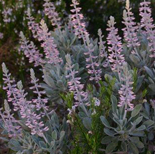
Lupinus aridorum is a rare species of lupine known by the common name scrub lupine. It is endemic to Florida in the United States, where there were 10 known populations remaining in 2003. Fewer than 6000 individual plants were counted. It is threatened by the loss and degradation of its habitat. The scrub lupine is a federally listed endangered species of the United States.

Lupinus arcticus is a species of flowering plant in the legume family known by the common names Arctic lupine or subalpine lupine. It is native to northwestern North America, where it occurs from Oregon north to Alaska and east to Nunavut. It is a common wildflower in British Columbia.















